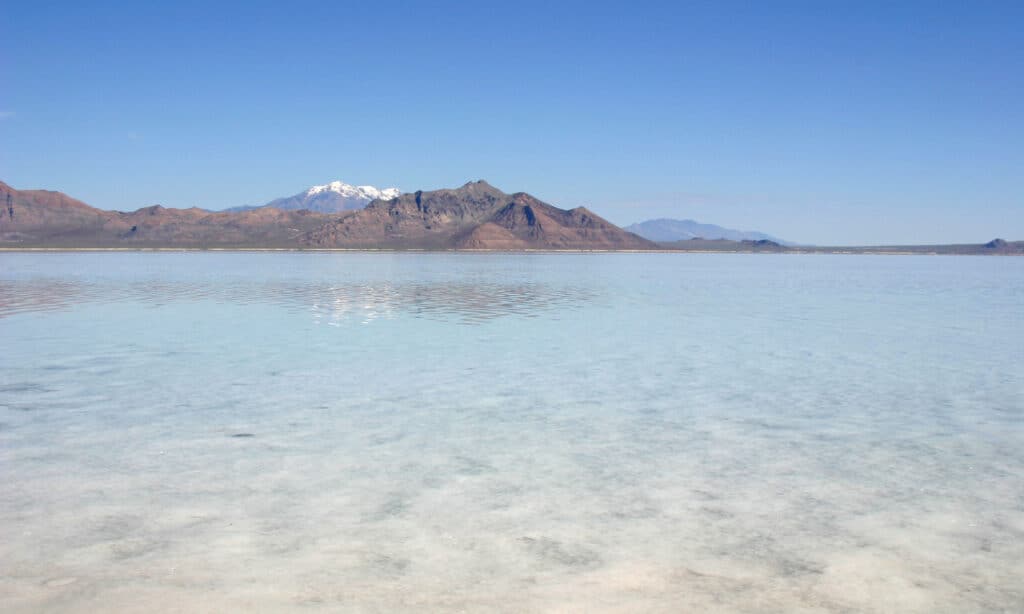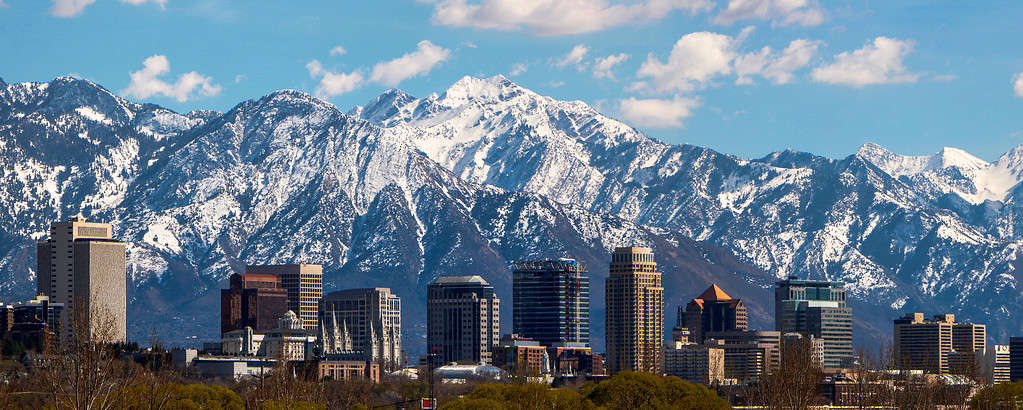The biggest saltwater lake in the Western Hemisphere is the Great Salt Lake in Utah. It is known as “America’s Dead Sea,” and it’s a well-known tourist destination for visitors wishing to float in its waters. But how salty is the Great Salt Lake? We’ll answer that question and more.
What Is the Great Salt Lake?

The Great Salt Lake is a terminal lake that is fed by the Weber, Bear, and Jordan Rivers.
©iStock.com/beccarie
The Great Salt Lake is a terminal lake which means that there is no outlet, and almost all water loss occurs through evaporation. It’s the remnants of a Late Pleistocene lake that was much bigger than the Great Salt Lake present today. The Weber, Bear, and Jordan Rivers flow into the lake, and these rivers are driven mainly by snowmelt.
Because the lake is so shallow, variations in precipitation amounts and evaporation caused by outside temperatures cause the lake’s level to shift dramatically. Since official records began in 1849, the lake’s shoreline has shifted back and forth over a distance of about 15 miles.
Where Is the Great Salt Lake?

Salt Lake City is on the southeastern shore of the Great Salt Lake.
©Joe Guetzloff/Shutterstock.com
The Great Salt Lake is in the Bonneville Basin in Utah. The Bonneville Basin is a depression within the larger geographical area called the Great Basin in the western United States. The lake lies at the lowest point of this massive basin.
The state’s capital, Salt Lake City, is near the southeastern shore of the lake. Salt Lake City is part of the Wasatch Front which is a developed city stretch that’s about 105 miles long from north to south. About 75 percent of the population of Utah lives in this metropolitan area.
Why is the Great Salt Lake Salty?

Water only leaves the Great Salt Lake through evaporation which makes it very salty.
©Bella Bender/Shutterstock.com
The Great Salt Lake is salty because water that travels into the lake only disappears through evaporation. This means that the salts, sediment, and minerals that flow into the lake do not flow out. As a result, they are left behind as water evaporates. Over two million tons of salt per year are brought into the lake by the rivers that flow into it, and all of this salt stays put once it arrives.
How Salty Is the Great Salt Lake?
The Great Salt Lake generally has a salinity between 6 and 28 percent. In comparison, the ocean’s salinity is 3 and a half percent. The lake’s salinity swings so dramatically because it’s a shallow lake that’s highly sensitive to precipitation levels and drought conditions in the region.
Salinity has steadily increased since 1847 because this is when humans began diverting freshwater sources that should flow into the lake naturally. Around 40 percent of all water meant for the lake is diverted, which has caused the lake’s volume and area to decrease by almost 50 percent. If current water-diverging practices aren’t changed, the lake will disappear by 2028.
The northwest arm, called Gunnison Bay, of the Great Salt Lake is saltier than the rest of the lake due to the construction of the Union Pacific Railroad causeway. Because of the constriction of water flow caused by the causeway, Gunnison Bay is a different color than the rest of the lake. This is because there is restricted water inflow into Gunnison Bay which allows for algal blooms that don’t occur elsewhere in the lake.
What Lives in the Great Salt Lake?

Green algae turn the Great Salt Lake’s water red in the north arm of the lake.
©Eric Broder Van Dyke/Shutterstock.com
Because the Great Salt Lake is so salty, the kind of life that makes its home there is limited. Despite this, the Great Salt Lake does play host to a variety of organisms.
The primary types of green algae living in the lake turn the water into different colors. Dunaleilla salina thrives in the saltier north arm of the lake, and it turns the water red. Dunaleilla virdis is prominent in the lake’s less salty south arm, and it turns the water green.
Brine fly larvae and brine shrimp (Artemia salina) live in the Great Salt Lake’s water. Two species of brine flies are found in the Great Salt Lake: Ephydra cinerea, and Ephydra hians. Almost all of the flies are the smaller Ephydra cinerea with less than one percent being the larger Ephydra hians.
The brine flies and brine shrimp survive on the copious amounts of bacteria and algae in the lake. There are around 30 different types of bacteria present in the lake’s water.
Humans harvest brine shrimp and larvae for use as commercial fish food. Around 40 percent of the world’s brine shrimp for sale originate from the Great Salt Lake.
The brine shrimp eggs in the lake are also harvested for use as sea monkeys which are hatched as short-lived novelty pets in the United States.
Birds that Rely on the Great Salt Lake

American avocets feast on the brine flies and brine shrimp in the Great Salt Lake.
©Don DeBold (donjd2) / CC BY 2.0, Flickr – Original / License
It’s estimated that there are over one hundred billion brine flies in and near the water at any given time. This sustains a large bird population at certain times of the year. While a lot of birds can’t handle the salt content of the water, some birds are capable of consuming the brine shrimp and flies that live in the lake.
Some of these bird species include snowy plovers (Charadrius nivosus), black-necked stilts (Himantopus mexicanus), American avocets (Recurvirostra americana), California gulls (Larus californicus), Wilson’s phalaropes (Phalaropus tricolor), red-necked phalaropes (Phalaropus lobatus), and eared greb (Podiceps nigricollis). These species of birds are at risk because the wetlands around the lake are disappearing. Also, salinity levels are killing off the flies and shrimp that sustain these bird populations.
Is the Great Salt Lake Polluted?
Yes, the Great Salt Lake is polluted. More than 70 percent of the wastewater from the nearby Watasch Front is released into the lake’s general area. If the Great Salt Lake continues to evaporate, it may turn into a toxic dustbowl that will poison Salt Lake City’s air.
Due to industrial air pollution near the lake, methylmercury levels in the lake are extremely high. This has resulted in an advisory for duck hunters to not consume the meat of northern shovelers (Spatula clypeata), common goldeneyes (Bucephala clangula), and cinnamon teals (Anas cyanoptera).
The lake also smells bad when water levels are low. Decomposing organic materials, like algae and brine shrimp, settle at the bottom of the lake. When water levels are low enough, this gas escapes from the bottom to the surface. This creates a rotten egg smell that is unpleasant.
Thank you for reading! Have some feedback for us? Contact the AZ Animals editorial team.








